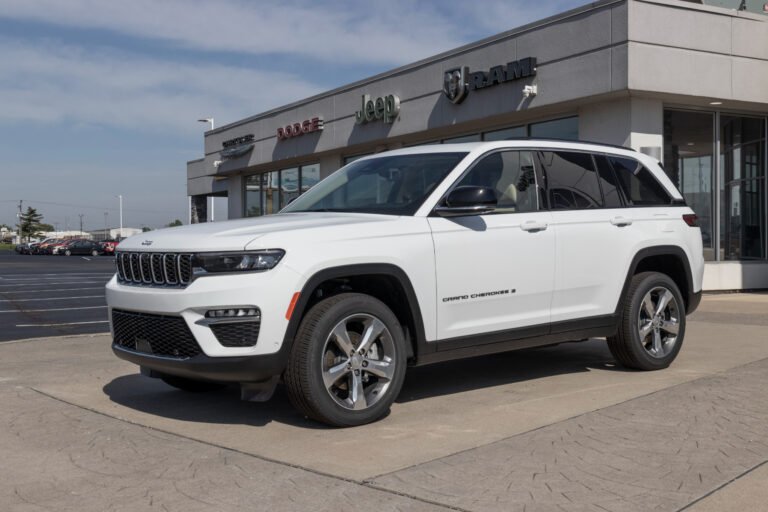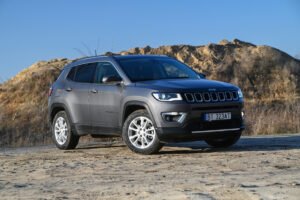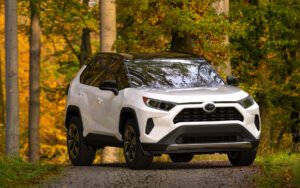The mid-size SUV segment is one of the most hotly-contested spaces in the American market. Therefore, the launch of the Jeep Grand Cherokee in the early 90s was a treat for prospective buyers.
Built on the new FCA Giorgio platform, the fifth-generation Grand Cherokee is both modern and well-sorted. As for its sticker price, this Jeep costs between $40,595 and $67,750 in the USA.
But those looking for other options in this category are not without promising choices. So, let’s check out the top 8 alternatives to the Jeep Grand Cherokee that you must consider.
1. Ford Bronco ($32,895 – $70,095)
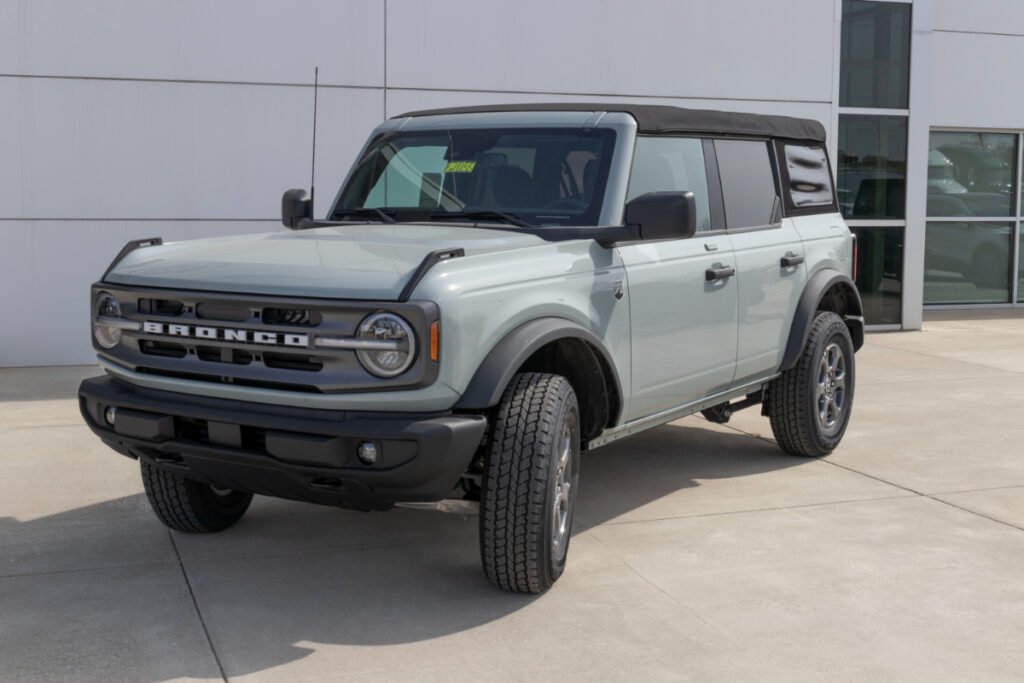
Similarities Between the Bronco and the Grand Cherokee
Both the Ford and Jeep SUVs are assembled in the USA and represent top American auto brands. For a long time, the Bronco also has been one of the top-selling SUVs in the country.
The two nameplates have been lauded for their off-roading capabilities, with the power to spin all four wheels. Both get electronically-locking rear differentials, disconnecting sway bars, multi-terrain & dedicated 4WD systems, and comparable ground clearances.
Even the Bronco can be had with an automatic transmission, while the base engines of both cars achieve similar EPA-rated mileage figures. They also share comparable wheelbases and front & rear tracks.
Like, Cherokee, the Bronco features two seating rows & similar cargo volume behind the second row. They get infotainment systems with Apple CarPlay & Android Auto, LED headlamps with Auto High-Beam, and Forward-Collision Warning.
What Makes the Ford Bronco Stand Out From the Cherokee?
Unlike the crossover-like and chiseled styling of the latter, the traditionally old-school design of the Bronco screams heritage and ruggedness. The Bronco is also available in two-door and four-door formats, with fan-favorite Hard-Top and Soft-Top iterations.
The interior of the Ford also exudes a sense of toughness and traditional 4×4 charm. It gets thicker pillars, flatter surfaces, and even removable doors for that ultimate off-road experience.
Here are the Ford Bronco’s other strengths:
- Turbocharged engines equal more power & quicker 0-60 times
- Entry-level variants are far cheaper
- It’s a proper body-on-frame SUV
- Far more capable on extremely-challenging terrain
- Can be equipped with a manual gearbox and 35-inch mud-terrain tires
If you want a tough, well-styled 4×4 with modern tech, the Ford Bronco is worth checking out. Scour the specifications table below for more details:
| Price | $32,895 – $70,095 |
| Fuel Efficiency | 17 MPG (City) / 17 MPG (Highway) |
| Engine | 2.7-Liter Twin-Turbocharged Regular Unleaded V6 |
| Horsepower | 315 hp |
| Torque | 410 lb-ft |
| Acceleration | 0 – 60 mph in 6.6 seconds |
| Top Speed | 106 mph |
| Body Style | Sport Utility Vehicle |
| Passenger Capacity | 5 |
| Drivetrain | Four-Wheel Drive |
| Transmission | 10-Speed Automatic |
2. Kia Telluride ($33,390 – $43,290)
Similarities Between the Telluride and the Cherokee
Like Cherokee, the Telluride is also capable of powering all four wheels via an automatic gearbox. Its similarly-sized V6 engine makes nearly the same amount of power as well. Kia’s fuel economy is identical to the Jeep’s too.
Both SUVs are just as tall, with their mid-spec variants being offered in a similar number of exterior colors. They also get flared wheel arches and a pretty flat roofline.
The cabin of the Telluride also feels spacious and comfortable. It scores split-folding rear seats, while there’s a good sense of quality being prevalent in both cars.
How Does the Kia Telluride Stand Out?
While the Grand Cherokee nameplate has been around for a while, the Telluride is a recent introduction. The Kia is also longer and wider and features a tougher front fascia and overall stance.
The Telluride is only available in a few trim levels and costs significantly less than the Grand Cherokee. However, even its mid-spec variant is offered in more exterior shades.
Here are some of the other fortes of the Kia Telluride:
- Can seat up to 8 people
- Gets larger alloy wheels as standard
- Boasts a larger infotainment screen
- Scores tri-zone automatic climate control
- It’s generally faster
If you want a well-built, well-equipped and well-priced three-row SUV, the Telluride will be a good choice. Check the specifications table below for more information:
| Price | $33,390 – $43,290 |
| Fuel Efficiency | 20 MPG (City) / 26 MPG (Highway) |
| Engine | 3.8-Liter Naturally-Aspirated Regular Unleaded V6 |
| Horsepower | 291 hp |
| Torque | 262 lb-ft |
| Acceleration | 0 – 60 mph in 7.2 seconds |
| Top Speed | 132 mph |
| Body Style | Sport Utility Vehicle |
| Passenger Capacity | 7 – 8 |
| Drivetrain | Front-Wheel Drive/All-Wheel Drive |
| Transmission | 8-Speed Automatic |
3. Hyundai Palisade ($34,950 – $48,900)
Similarities Between the Hyundai Palisade and the Jeep Grand Cherokee
Just like the Grand Cherokee, the Palisade can also be had with a six-cylinder engine that’s mated to an automatic gearbox, which can then spin all four tires. Both SUVs are based on unibody platforms as well.
The two cars share comparable exterior width and their mid-variants are offered in a similar number of colors. The base variants of both get a nearly-identical amount of ground clearance, too.
On the inside, the Palisade also feels suitably upmarket and plush. Furthermore, there are enough textured materials and different trim bits to elevate the overall ambiance of each cabin.
Where Does the Palisade Trump the Cherokee?
To begin with, the Korean SUV is larger than the latter in certain metrics. It’s also a far newer brand name than the Grand Cherokee.
Moreover, the Hyundai Palisade’s exterior design is far more fashion-centric and bolder than the Grand Cherokee. It also looks newer, flashier, and more upscale, even in its entry-level avatar.
The interior of the Palisade is also a more practical and roomier environment, with minimalistic yet thoughtful design apparent all over. Build quality is commendable, while the digital dials are easy to comprehend as well.
Here are the Hyundai Palisade’s other notable specialties:
- Has room for up to 8 occupants
- Quicker to 60 mph with higher top speed
- Even the base variant gets a 12.3-inch touch-display with Wi-Fi hotspot
- Noticeably cheaper than the Grand Cherokee
The Hyundai Palisade will satiate your appetite for a well-built, comfortable, tech-laden and roomy family SUV. Read the specifications table below for more insight:
| Price | $34,950 – $48,900 |
| Fuel Efficiency | 19 MPG (City) / 27 MPG (Highway) |
| Engine | 3.8-Liter Naturally-Aspirated Regular Unleaded V6 |
| Horsepower | 291 hp |
| Torque | 262 lb-ft |
| Acceleration | 0 – 60 mph in 7.2 seconds |
| Top Speed | 132 mph |
| Body Style | Sport Utility Vehicle |
| Passenger Capacity | 7 – 8 |
| Drivetrain | Front-Wheel Drive/All-Wheel Drive |
| Transmission | 8-Speed Automatic |
4. Nissan Pathfinder ($36,295 – $51,165)
Similarities Between the Nissan Pathfinder and the Grand Cherokee
Like the Grand Cherokee, the Pathfinder is also a modern unibody SUV in its fifth-generation avatar. Both cars feature independent suspension all around, a comparable towing capacity, and are offered two-wheel drive and four-wheel drive variants.
Both cars are sold in at least five trim levels, with six-cylinder engines and automatic gearboxes available as standard. Their general MPG and horsepower figures are also similar.
The Pathfinder also gets features like automatic LED headlights, Android Auto & Apple CarPlay, tilt and telescoping steering column, Forward Collision Warning with Pedestrian Detection, Blind Spot Warning, and High Beam Assist.
What Makes the Nissan Pathfinder Special?
Unlike the Jeep’s box-like and straight-lined body shell, the Nissan SUV sports a curvier and contoured outer silhouette. It is longer and also looks more robust than the Jeep.
The Pathfinder’s passenger volume is greater than that of the base Grand Cherokee, while the cabin itself is capable of carrying eight occupants. Moreover, the interior of the Pathfinder feels even airier overall.
Here are some of the other pertinent goodness the Pathfinder offers over the Jeep:
- Quicker to 60 mph
- Much more affordable
- Better cabin insulation
- More practical storage spaces
- Easier to drive in the city
In case you want a comfortable and reliable family SUV with three rows of seats, the Pathfinder should be on your shortlist. In the meantime, check out the car’s specifications table:
| Price | $36,295 – $51,165 |
| Fuel Efficiency | 21 MPG (City) / 27 MPG (Highway) |
| Engine | 3.5-Liter Naturally-Aspirated Regular Unleaded V6 |
| Horsepower | 284 hp |
| Torque | 259 lb-ft |
| Acceleration | 0 – 60 mph in 7.0 seconds |
| Top Speed | 119 mph |
| Body Style | Sport Utility Vehicle |
| Passenger Capacity | 7 – 8 |
| Drivetrain | Front-Wheel Drive/All-Wheel Drive |
| Transmission | 9-Speed Automatic |
5. Ford Explorer ($37,650 – $55,770)
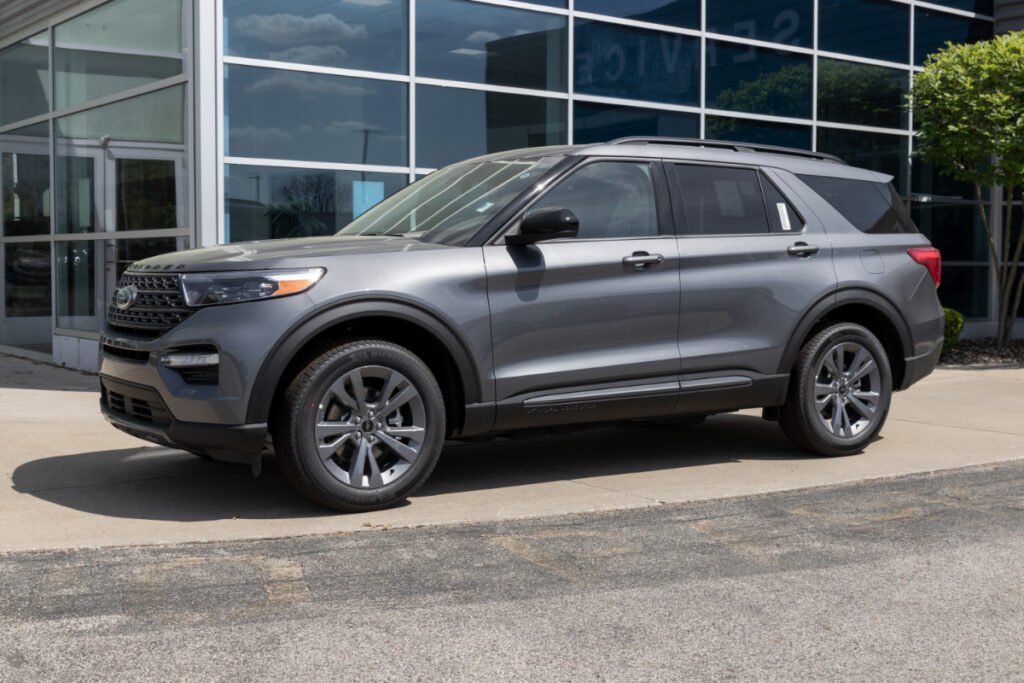
Similarities Between the Ford Explorer and the Jeep Grand Cherokee
The Ford Explorer and the Jeep Grand Cherokee are both mid-size unibody SUVs from historic American auto marques that arrived initially in the early 1990s. The two recently got updated to their latest models, too.
These five-door SUVs further feature other comparable similarities like chiseled yet strong contours on the outside, complemented by friendly-yet SUV-like bodylines.
The Explorer also gets two-wheel drive and four-wheel drive options, while a six-cylinder engine mated to an automatic torque-converter gearbox is available as well. Both SUVs can be had with optional 21-inch alloy wheels.
On the features front, the Ford Explorer can also be equipped with Auto High-Beam Headlamps, Adaptive Cruise Control with Pedestrian Detection, Lane-Keeping System, Blind Spot Monitoring, and Automatic-Emergency Braking.
Where Does the Ford Explorer Take the Lead?
For starters, the Ford definitely looks the sportier of the two. Its eager and muscular front fascia lends the Explorer a more ‘ready-to-act’ demeanor. The Explorer is also available in more standard colors across more trim levels.
Where the Jeep’s cabin leans towards sophistication, the Ford’s feel sportier. There’s racy contrast stitching across the cabin, with a flat-bottom steering wheel and aluminum finish on the center console.
Take a look at some of the Explorer’s other goodie points below:
- Faster to 60 mph and post that as well
- Sporty driving dynamics
- Can seat up to 7 people
- Longer body and wheelbase
- More available rear boot space
If you want a sporty driving experience at a justifiable price tag with three rows behind you, you won’t be disappointed by the Ford Explorer. Check out the specifications below for more insight:
| Price | $37,650 – $55,770 |
| Fuel Efficiency | 18 MPG (City) / 24 MPG (Highway) |
| Engine | 3.0-Liter Twin-Turbocharged Regular Unleaded V6 |
| Horsepower | 400 hp |
| Torque | 415 lb-ft |
| Acceleration | 0 – 60 mph in 5.5 seconds |
| Top Speed | 146 mph |
| Body Style | Sport Utility Vehicle |
| Passenger Capacity | 6 – 7 |
| Drivetrain | Front-Wheel Drive/All-Wheel Drive |
| Transmission | 10-Speed Automatic |
6. Honda Passport ($38,370 – $45,930)
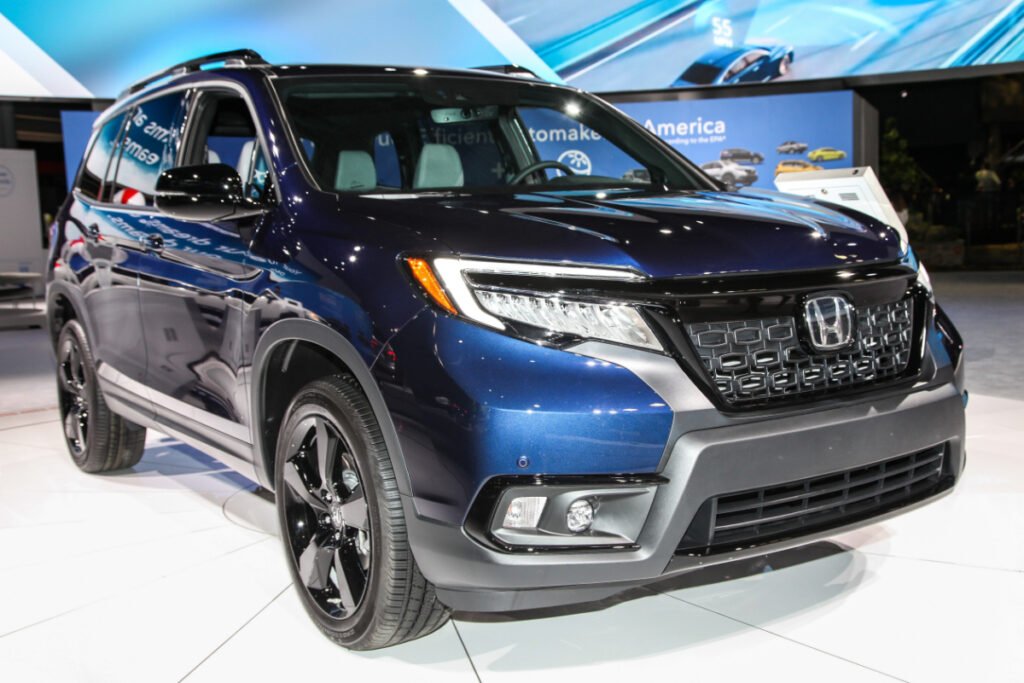
Similarities Between the Honda Passport and the Cherokee
Originating in the 1990s, the Passport has been a ‘passport’ for Honda to make its entry into the mid-size SUV segment – much like the Grand Cherokee. With its recent iteration, both these cars are doing quite well.
These cars also share similar exterior profiles in terms of their width, with the two being equipped with almost-identical levels of ground clearance in their base variants. The side profiles of both cars look almost similar, too.
Even the Honda Passport can be had with a six-cylinder gas engine with around the same torque figure, an automatic transmission, all-around independent suspension, and dual-exhaust tips at the back.
Regarding the equipment list, the Passport also gets Android Auto & Apple CarPlay, an optional Wi-Fi hotspot, Lane-Departure Warning with Lane-Keeping Assist, Blind-Spot Monitoring, and multi-terrain drive modes.
Here’s How the Passport Differentiates Itself from the Cherokee
Even in its base form, the Passport exudes a sense of toughness while being a seemingly-easy design. There are only three trim levels to choose from – all of them being cheaper than the Jeep.
The higher trim of the Passport gets plenty of black trim, which makes it look sportier than the Grand Cherokee. On the inside, the sportier-looking Honda features a user-friendly interface all over.
Even the base variant of the Passport gets all-wheel drive with Traction Management modes, heated front leather seats, an electric sunroof, three-zone climate control, and a powered tailgate.
Here are the other strengths of the Honda Passport:
- Much cheaper
- Offers more space on the inside
- Gets a wireless phone charger
- Features Honda’s Multi-Angle Rearview Camera
- Quicker to 60 mph
Honda Passport won’t let you down as a reliable, well-engineered, safe and good-performing family mid-size SUV. Now, check out the specifications table below to know more about this car:
| Price | $38,370 – $45,930 |
| Fuel Efficiency | 19 MPG (City) / 24 MPG (Highway) |
| Engine | 3.5-Liter Naturally-Aspirated Regular Unleaded V6 |
| Horsepower | 280 hp |
| Torque | 262 lb-ft |
| Acceleration | 0 – 60 mph in 6.4 seconds |
| Top Speed | 111 mph |
| Body Style | Sport Utility Vehicle |
| Passenger Capacity | 5 |
| Drivetrain | Front-Wheel Drive/All-Wheel Drive |
| Transmission | 9-Speed Automatic |
7. Dodge Durango ($38,495 – $68,960)
Similarities Between the Dodge Durango and the Jeep Grand Cherokee
The Dodge Durango is also an all-American SUV hailing from the US, and it shares its unibody underpinnings with the Jeep Grand Cherokee. In fact, both cars are put-together at the exact same facility.
Durango also features a fully-independent suspension and comparable six-cylinder engines paired with torque-converter transmissions that drive the rear wheels as standard.
They also get similar-sized fuel tanks and identical base MPG figures, while the entry-level version of the Durango is also tow-rated at 6200 pounds.
Some other features of the Grand Cherokee alternative include automatic LED headlamps, dual-zone climate control, an 8.4-inch touchscreen with Apple CarPlay & Android Auto, Blind-Spot Warning, and Stability Control with Roll Mitigation.
How Does the Dodge Durango Take the Lead?
Right away, you’ll notice that the Dodge Durango is a larger car than its Jeep competitor. It’s much longer and boasts a longer wheelbase as well.
Compared to the Cherokee’s flat-ish profile and straight lines, the Durango’s curvier body looks more muscular and sculpted. Its interior design has a more conventional layout, but it’s angled toward the driver.
The Durango’s cabin also feels better insulated yet more rugged and boasts soft-touch materials and slightly-better ergonomics. Its maximum cargo volume is also greater than that of the Jeep.
Here are some more of the Dodge Durango’s key USPs:
- Its base variants are cheaper
- Can tow up to 8700 pounds
- Gets a 6.4-liter V8 that produces 475hp
- The SRT 392 hits 60 mph in 4.7 seconds and a top speed of 160 mph
- The Durango can seat up to 7 people
If you want a spacious & practical three-row SUV that’s fun to drive yet comfortable, the Dodge will be a good alternative to the Grand Cherokee. Below is the Durango’s specifications table:
| Price | $38,495 – $68,960 |
| Fuel Efficiency | 14 MPG (City) / 22 MPG (Highway) |
| Engine | 5.7-Liter Naturally-Aspirated Regular Unleaded V8 |
| Horsepower | 360 hp |
| Torque | 390 lb-ft |
| Acceleration | 0 – 60 mph in 6.2 seconds |
| Top Speed | 120 mph |
| Body Style | Sport Utility Vehicle |
| Passenger Capacity | 6 – 7 |
| Drivetrain | Rear-Wheel Drive/All-Wheel Drive |
| Transmission | 8-Speed Automatic |
8. Toyota 4Runner ($39,640 – $54,605)

Similarities Between the Toyota 4Runner and the Grand Cherokee
Just like the Grand Cherokee, the Toyota 4Runner is also a mid-size SUV that’s presently in its fifth generation. Both are top-selling models from their respective manufacturers.
The Grand Cherokee alternative also comes with a six-cylinder gas engine that’s mated to an automatic gearbox, while the rear-wheel drive is available in both cars. The 4Runner’s 0-60 time is also comparable to the Jeep’s.
The Toyota also scores LED headlamps, keyless entry, split-folding rear seats, a leather-wrapped multifunction steering wheel, a touch-infotainment system with Android Auto & Apple CarPlay, TPMS, and Forward Collision Warning with Pedestrian Detection.
Differentiating Features That the 4Runner Boasts
The 4Runner looks vastly more rugged and trail-ready than its Jeep competitor. In fact, the whole design emanates a sense of old-school charm and toughness.
The Toyota is also available in more trim levels, with the TRD Off-Road variants being designed specifically for tackling challenging terrain. The 4Runner is taller and gets 9.6 inches of ground clearance, too.
The interior of the 4Runner is decidedly more utilitarian and built to be used with gloves on, while all the touch-points & dials are easy to operate and feel sturdy.
Here are the 4Runner’s other unique features:
- It’s a true body-on-frame SUV
- Has room for up to 7 occupants
- Features Toyota’s Kinetic Dynamic Suspension System (KDSS) & Multi-Terrain Select (MTS)
- Gets a larger boot
- Available with all-terrain tires & high-performance TRD Fox shocks
The 4Runner is for you if you want a true-blue 4×4 that’s extremely capable, reliable, and well-equipped family hauler. Here’s the Toyota SUV’s specifications table:
| Price | $39,640 – $54,605 |
| Fuel Efficiency | 16 MPG (City) / 19 MPG (Highway) |
| Engine | 4.0-Liter Naturally-Aspirated Regular Unleaded V6 |
| Horsepower | 270 hp |
| Torque | 278 lb-ft |
| Acceleration | 0 – 60 mph in 7.9 seconds |
| Top Speed | 113 mph |
| Body Style | Sport Utility Vehicle |
| Passenger Capacity | 5 – 7 |
| Drivetrain | Rear-Wheel Drive/Four-Wheel Drive |
| Transmission | 5-Speed Automatic |
Who is Jeep’s biggest competitor?
The Jeep’s biggest competitor is Ford.
Why are Jeep Grand Cherokees popular?
The Jeep Grand Cherokee has been popular among owners for its ability to tackle rough terrain, while being able to tow heavy loads and offering a spacious yet comfortable cabin.
How long will a Jeep Grand Cherokee last?
If maintained well and serviced regularly, a Jeep Grand Cherokee can easily last for over two decades and/or 200,000 miles.
These cars are some of the top alternatives to the Jeep Grand Cherokee, and they’re all definitely worth checking out. Competitors like the Bronco and 4Runner are for you if you want fully-fledged off-roaders, while the Explorer and Durango are fun-to-drive yet practical family SUVs.
If excellent VFM and modern features excite you, then Telluride and Palisade will be tempting deals. Meanwhile, the Pathfinder and Passport are great alternatives if you want stylish and feature-laden three-row SUVs. That said, pick your best car and take it for a test drive!

